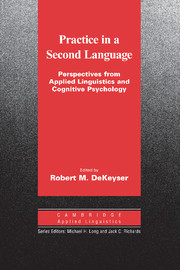III: INDIVIDUAL DIFFERENCES
Published online by Cambridge University Press: 27 January 2010
Summary
This section deals with two of the individual learner differences that are most likely to affect various aspects of language learning in general and to determine what practice activities are optimal for learners characterized by these differences in particular. The most obvious difference is age, a factor that is widely considered to have dramatic effects on language learning success. In her chapter on age differences and their implications for practice, however, Carmen Muñoz presents evidence that the difference between young children on the one hand and adolescents or adults on the other is qualitative rather than quantitative. Older learners learn largely explicitly, using their ability to reason abstractly, while children learn largely implicitly, using their memory for concrete instances of language use. As a result, given the same amount of classroom exposure and practice, adolescents and adults actually make more progress than children because the traditional classroom context allows these older learners to draw on their superior analytical skills. As Muñoz illustrates in detail, it is important that classroom practice activities capitalize on the very different strengths in memory and analytical ability of children and adults by being adaptive to their age.
As older learners draw more on their analytical skills, individual differences in these skills will play an important role, as long as the learning conditions allow for these skills to come into play.
- Type
- Chapter
- Information
- Practice in a Second LanguagePerspectives from Applied Linguistics and Cognitive Psychology, pp. 227 - 228Publisher: Cambridge University PressPrint publication year: 2007



